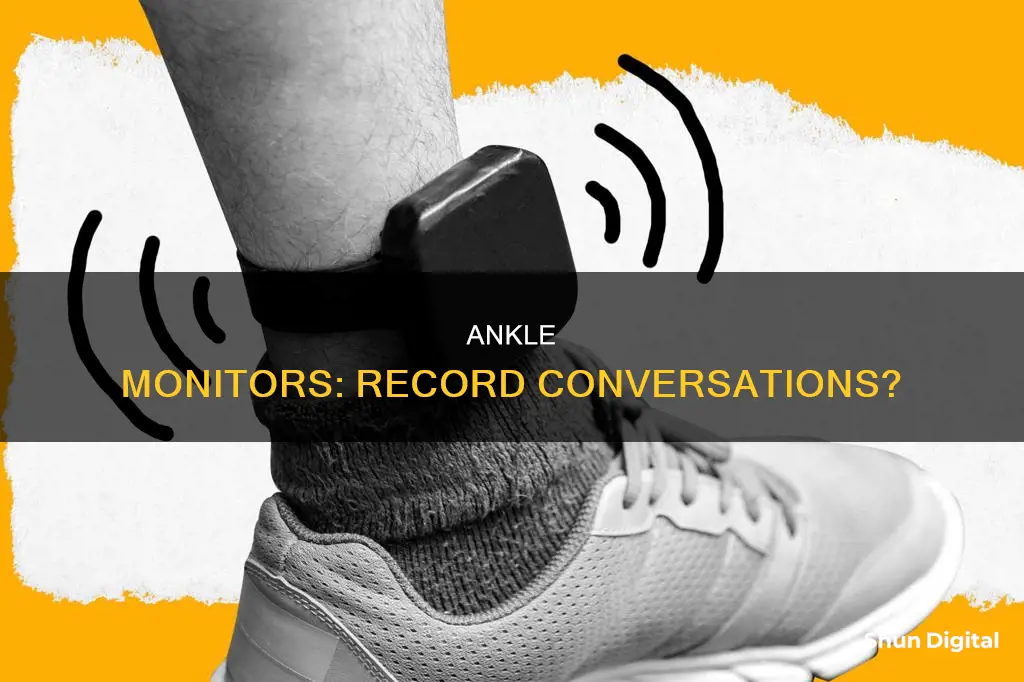
Ankle monitors are often used as an alternative to jail time, allowing individuals to remain free while awaiting trial or serving probation. They are typically used to track the location of the wearer and ensure they abide by the terms of their sentence, such as restricted travel or maintaining sobriety. While ankle monitors do not always have microphones, newer models have been introduced with two-way communication capabilities, raising concerns about privacy and dignity. This has sparked debates over the benefits of enhanced supervision versus the potential invasion of privacy and intrusion into individuals' lives.
| Characteristics | Values |
|---|---|
| Purpose | To ensure the wearer doesn't get into more trouble, to ensure they stay within boundaries set by the court, to reduce bail, to replace incarceration, to monitor sobriety, to deter repeat behaviour |
| Functionality | Tracks location, can set a curfew, can detect alcohol in sweat, can be used for two-way communication |
| Use cases | For people deemed a flight risk, for non-violent crimes, for people awaiting trial, for people serving probation and parole, for people facing immigration proceedings, for repeat offenders, for DUI or DWI convictions, for domestic violence cases |
| Cost | $3-$35 per day, plus initial setup charges of $100-$200 |
| Effectiveness | Studies show that monitors fail to demonstrably meet their goals of ensuring court appearance, protecting public safety, and advancing rehabilitation. However, a 2006 study of 75,661 Florida offenders showed that those who wore electronic tags were 91.2% less likely to abscond and 94.7% less likely to commit new offences. |
What You'll Learn

Ankle monitors can be used to ensure sobriety
Ankle monitors are often used as an alternative to jail sentences for people with substance abuse issues. They are used to track the movements of individuals who have been sentenced to restricted travel or activities. For example, DUI offenders are required to wear an ankle monitor to monitor their blood alcohol concentration. These are known as Secure Continuous Remote Alcohol Monitors (SCRAM) or Continuous Alcohol Monitoring (CAM) bracelets.
The SCRAM/CAM bracelet provides 24/7 transdermal alcohol testing by sampling the wearer's perspiration every 30 minutes. This skin-level measurement is known as the "transdermal" alcohol concentration. The monitor will test the wearer's sweat while they are sleeping, at work, out with friends, or not profusely sweating. The data is then transmitted to a wireless base station and uploaded to monitoring software, where it is analysed by trained professionals. If the wearer is found to be in violation of their release conditions, the relevant authorities are alerted.
The use of SCRAM/CAM bracelets has been shown to increase compliance with court orders and improve community safety. They provide accountability and encourage behaviour change, helping people achieve more sober days. This form of monitoring can be particularly useful for repeat offenders, ensuring sobriety and deterring them from committing further offences.
While ankle monitors can be an effective tool for ensuring sobriety, it is important to note that they may also come with challenges and restrictions for the wearer. For example, there may be financial costs associated with the monitor, and wearers may need to modify their daily tasks and routines to accommodate the device. Additionally, in some cases, ankle monitors may be seen as a form of digital incarceration, leading to social isolation and stigma.
Calibrating Your ASUS Monitor: Perfect Color Display
You may want to see also

They can detect alcohol in a person's sweat
It is important to clarify that ankle monitors are typically used for house arrest or parole purposes and are designed to track an individual's location and ensure they remain within a designated area. While ankle monitors do not record oral conversations, they do have advanced capabilities, including the ability to detect alcohol in a person's sweat. This feature addresses concerns about alcohol consumption, which could violate the terms of an individual's house arrest or parole.
The technology utilized in ankle monitors to detect alcohol is known as Transdermal Alcohol Testing. This method measures the amount of alcohol that permeates through the skin and is released via sweat. The ankle monitor includes a sensor that analyzes the sweat for alcohol content, providing an accurate reading. This capability is especially relevant for individuals on house arrest or parole, as alcohol consumption is often prohibited, and violations can result in legal repercussions.
Transdermal Alcohol Testing offers a non-invasive and convenient approach to monitoring alcohol consumption. The ankle monitor continuously collects and analyzes data, providing real-time information on any alcohol consumption. This technology is highly sensitive and can detect even low levels of alcohol in the sweat. The data collected by the ankle monitor can be transmitted to a central monitoring system, allowing authorities to be immediately alerted if alcohol is detected.
The inclusion of Transdermal Alcohol Testing in ankle monitors serves as a deterrent for individuals on house arrest or parole. Knowing that their alcohol consumption can be easily detected and reported may encourage better behavior and compliance with the terms of their release or parole conditions. This technology enhances the effectiveness of the criminal justice system by providing a tool to monitor and address alcohol-related issues, which are often associated with criminal behavior.
Finding Dead Pixels on Your LCD Monitor
You may want to see also

They can be used as an alternative to jail time
Ankle monitors are increasingly being used as an alternative to traditional imprisonment, allowing individuals to serve their sentences while remaining in the community. This form of supervision is often employed for those on probation or parole, or for those awaiting trial. It is also an option for individuals convicted of a crime who are considered low-risk and not a danger to the community.
The use of ankle monitors has several advantages over incarceration in jails or prisons. Firstly, it is less expensive to monitor individuals in this way, and it also allows them to maintain their employment and support their families. This can facilitate their reintegration into society once their sentences are completed.
However, there are also disadvantages to this form of supervision. Ankle monitors can be uncomfortable to wear and may cause skin irritation. Additionally, individuals with ankle monitors are typically subject to strict rules and regulations, and any violation of these rules can result in additional penalties or even imprisonment.
While ankle monitors can provide an alternative to jail time, it is important to note that they are not a suitable punishment for all individuals and should be used with discretion. The offender's risk of reoffending and the nature of the crime must be carefully considered when deciding whether to use an ankle monitor.
ViewSonic VA1938wa-LED: Does it Have HDMI?
You may want to see also

They can be used to ensure a person doesn't leave a designated area
Ankle monitors are used as an alternative to jail sentences, especially for non-violent crimes. They are also used to ensure that a person doesn't leave a designated area. The monitor is strapped to the person's ankle and is about the size of a pager. It uses GPS to track the wearer's location. If the person goes outside the designated area, the device vibrates and emits a loud tone, notifying them that they are about to violate the conditions of their release. If they don't return to the designated area, the device sends an alert to the authorities.
The use of ankle monitors ensures that the wearer stays within the boundaries set by the court and helps to reduce the risk of re-offending. It is a way to ensure the person doesn't leave a designated area and also helps them avoid jail time.
The terms and conditions of ankle monitor usage can vary depending on the individual's situation. They may be restricted to a specific area or have a curfew they must adhere to. Ankle monitors are typically used for people who are considered a flight risk or a danger to the community.
In some cases, ankle monitors can also be used to detect alcohol consumption. For example, a Secure Continuous Remote Alcohol Monitor (SCRAM) bracelet can detect alcohol in a person's sweat and alert authorities if they violate the terms of their release.
While ankle monitors can be an effective tool for monitoring and deterring repeat behaviour, there are concerns about the invasion of privacy and the stigma associated with their use.
Asus Monitor Warranty: How to Check Your Coverage?
You may want to see also

They can be used to prevent domestic violence
Ankle monitors are increasingly being used to prevent domestic violence and protect victims. In the US, one in three women experience domestic violence abuse, including battery, intimidation, rape, and stalking in intimate relationships. This can be particularly acute when victims attempt to leave their abusers, a phenomenon known as "separation assault", which can sometimes be fatal.
Ankle monitors are used to ensure that offenders comply with protection, restraining, and/or stay-away orders. Courts will require some evidence of domestic violence, such as a history of abuse, a record of violating orders, or police reports that indicate the victim is at risk.
The monitors use GPS tracking to ensure offenders avoid certain "zones", such as the victim's home or workplace, and can also enforce lifestyle restrictions, such as curfews or exclusion from bars. This gives victims peace of mind and has likely saved lives, according to the head of PEI Family Violence Prevention Services.
In addition, the fear of consequences for breaching probation helps keep offenders on their best behaviour. The monitors also allow offenders certain freedoms, such as being able to live at home, go to work, and live their life.
The use of ankle monitors in domestic violence cases has been described as a victim-centred approach taken by the justice system, allowing victims to remain in their homes safely, rather than having to seek shelter or stay with family or friends.
Monitoring BitMEX Position Size: A Comprehensive Guide
You may want to see also
Frequently asked questions
Ankle monitors are typically used to track the location of individuals who have been sentenced to restricted travel or activities. Some ankle monitors have a built-in microphone, while others do not. The feature varies from monitor to monitor and from company to company.
Under California Penal Code Section 1203.016 PC, it is against the law for the state to use the built-in microphone to eavesdrop on conversations. Any other conduct would likely be a violation of the defendant's Fourth Amendment and possibly Fifth Amendment rights.
Ankle monitors can help deter repeat behavior and ensure individuals abide by the terms of their sentence. They can also be used as an alternative to jail time, especially for individuals with substance abuse issues.
There are concerns about the privacy and dignity of individuals wearing ankle monitors, especially with the newer models that have two-way communication capabilities. Additionally, there is a financial burden associated with the cost of renting and using these devices.







